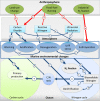Benthic N2 fixation in coral reefs and the potential effects of human-induced environmental change
- PMID: 24967086
- PMCID: PMC4063469
- DOI: 10.1002/ece3.1050
Benthic N2 fixation in coral reefs and the potential effects of human-induced environmental change
Abstract
Tropical coral reefs are among the most productive and diverse ecosystems, despite being surrounded by ocean waters where nutrients are in short supply. Benthic dinitrogen (N2) fixation is a significant internal source of "new" nitrogen (N) in reef ecosystems, but related information appears to be sparse. Here, we review the current state (and gaps) of knowledge on N2 fixation associated with coral reef organisms and their ecosystems. By summarizing the existing literature, we show that benthic N2 fixation is an omnipresent process in tropical reef environments. Highest N2 fixation rates are detected in reef-associated cyanobacterial mats and sea grass meadows, clearly showing the significance of these functional groups, if present, to the input of new N in reef ecosystems. Nonetheless, key benthic organisms such as hard corals also importantly contribute to benthic N2 fixation in the reef. Given the usually high coral coverage of healthy reef systems, these results indicate that benthic symbiotic associations may be more important than previously thought. In fact, mutualisms between carbon (C) and N2 fixers have likely evolved that may enable reef communities to mitigate N limitation. We then explore the potential effects of the increasing human interferences on the process of benthic reef N2 fixation via changes in diazotrophic populations, enzymatic activities, or availability of benthic substrates favorable to these microorganisms. Current knowledge indicates positive effects of ocean acidification, warming, and deoxygenation and negative effects of increased ultraviolet radiation on the amount of N fixed in coral reefs. Eutrophication may either boost or suppress N2 fixation, depending on the nutrient becoming limiting. As N2 fixation appears to play a fundamental role in nutrient-limited reef ecosystems, these assumptions need to be expanded and confirmed by future research efforts addressing the knowledge gaps identified in this review.
Keywords: Coral reefs; cyanobacteria; deoxygenation; diazotrophs; dinitrogen fixation; eutrophication; global warming; ocean acidification; symbiosis; ultraviolet radiation stress.
Figures




Similar articles
-
Nitrogen fixation and denitrification activity differ between coral- and algae-dominated Red Sea reefs.Sci Rep. 2021 Jun 3;11(1):11820. doi: 10.1038/s41598-021-90204-8. Sci Rep. 2021. PMID: 34083565 Free PMC article.
-
ENCORE: the effect of nutrient enrichment on coral reefs. Synthesis of results and conclusions.Mar Pollut Bull. 2001 Feb;42(2):91-120. doi: 10.1016/s0025-326x(00)00181-8. Mar Pollut Bull. 2001. PMID: 11381890
-
Monitoring of coastal coral reefs near Dahab (Gulf of Aqaba, Red Sea) indicates local eutrophication as potential cause for change in benthic communities.Environ Monit Assess. 2015 Feb;187(2):44. doi: 10.1007/s10661-014-4257-9. Epub 2015 Jan 31. Environ Monit Assess. 2015. PMID: 25637388
-
Operationalizing resilience for adaptive coral reef management under global environmental change.Glob Chang Biol. 2015 Jan;21(1):48-61. doi: 10.1111/gcb.12700. Epub 2014 Sep 5. Glob Chang Biol. 2015. PMID: 25196132 Free PMC article. Review.
-
Multi-partner interactions in corals in the face of climate change.Biol Bull. 2012 Aug;223(1):66-77. doi: 10.1086/BBLv223n1p66. Biol Bull. 2012. PMID: 22983033 Review.
Cited by
-
Coral-Associated Bacterial Diversity Is Conserved across Two Deep-Sea Anthothela Species.Front Microbiol. 2016 Apr 5;7:458. doi: 10.3389/fmicb.2016.00458. eCollection 2016. Front Microbiol. 2016. PMID: 27092120 Free PMC article.
-
Coral Reef Microorganisms in a Changing Climate.iScience. 2020 Apr 24;23(4):100972. doi: 10.1016/j.isci.2020.100972. Epub 2020 Mar 9. iScience. 2020. PMID: 32208346 Free PMC article. Review.
-
Spatio-temporal variation in stable isotope signatures (δ13C and δ15N) of sponges on the Saba Bank.PeerJ. 2018 Aug 14;6:e5460. doi: 10.7717/peerj.5460. eCollection 2018. PeerJ. 2018. PMID: 30128208 Free PMC article.
-
The Assimilation of Diazotroph-Derived Nitrogen by Scleractinian Corals Depends on Their Metabolic Status.mBio. 2017 Jan 10;8(1):e02058-16. doi: 10.1128/mBio.02058-16. mBio. 2017. PMID: 28074021 Free PMC article.
-
Nitrogen Fixation in Thermophilic Chemosynthetic Microbial Communities Depending on Hydrogen, Sulfate, and Carbon Dioxide.Microbes Environ. 2018 Mar 29;33(1):10-18. doi: 10.1264/jsme2.ME17134. Epub 2018 Jan 24. Microbes Environ. 2018. PMID: 29367473 Free PMC article.
References
-
- Albert S, O'Neil JM, Udy JW, Ahern KS, O'Sullivan CM, Dennison WC. Blooms of the cyanobacterium Lyngbya majuscula in coastal Queensland, Australia: disparate sites, common factors. Mar. Pollut. Bull. 2005;51:428–437. - PubMed
-
- Alongi DM, McKinnon AD. The cycling and fate of terrestrially-derived sediments and nutrients in the coastal zone of the Great Barrier Reef shelf. Mar. Pollut. Bull. 2005;51:239–252. - PubMed
-
- Andersson AJ, Yeakel KL, Bates NR, De Putron SJ. Partial offsets in ocean acidification from changing coral reef biogeochemistry. Nat. Clim. Chang. 2014;4:56–61.
-
- Arp DJ. The nitrogen cycle. In: Triplett EW, editor. Prokaryotic nitrogen fixation: a model system for the analysis of a biological process. Wymondham: Horizon Scientific Press; 2000. pp. 1–14.
Publication types
LinkOut - more resources
Full Text Sources
Other Literature Sources
Research Materials

